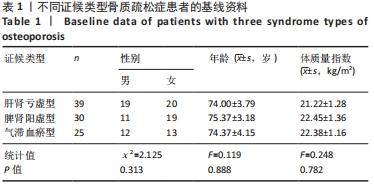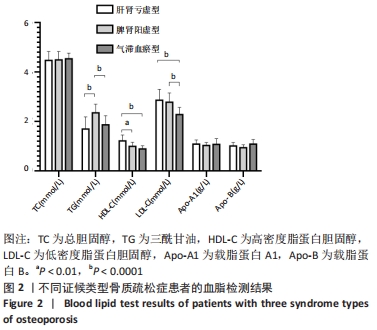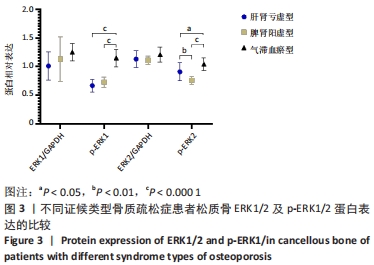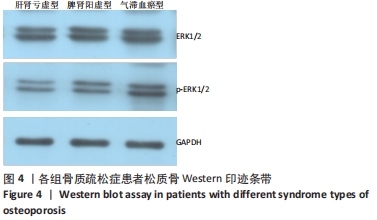中国组织工程研究 ›› 2022, Vol. 26 ›› Issue (29): 4704-4708.doi: 10.12307/2022.907
• 骨组织构建 bone tissue construction • 上一篇 下一篇
老年性骨质疏松症中医证型与脂代谢中细胞外信号调节激酶的相关性
廖荣臻1,陈德骏2,何敏聪1,黄幸儒1,方 坚1,朱根福1
- 1广州中医药大学第三附属医院(广东省中医骨伤研究院),广东省广州市 510378;2广州中医药大学第三临床医学院,广东省广州市 510006
Correlation between TCM syndrome types and ERK in lipid metabolism of senile osteoporosis
Liao Rongzhen1, Chen Dejun2, He Mincong1, Huang Xingru1, Fang Jian1, Zhu Genfu1
- 1The Third Affiliated Hospital of Guangzhou University of Chinese Medicine, Guangzhou 510378, Guangdong Province, China; 2The Third Clinical Medical College of Guangzhou University of Chinese Medicine, Guangzhou 510006, Guangdong Province, China
摘要:
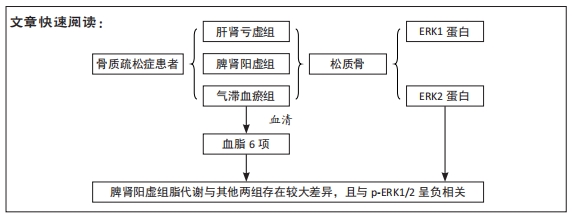
文题释义:
骨质疏松症:是一种以骨矿物质密度降低和骨强度受损为特征的常见疾病,研究表明脂代谢与骨质疏松存在密切关系,脂代谢异常能促进破骨细胞活化、分化、发育,使骨吸收能力增强,骨平衡受到破坏,从而引起骨质疏松。
细胞外信号调节激酶(extracellular regulated protein kinases,ERK):属于MAPK中的一个亚家族,ERK1/2信号通路对成骨细胞的增殖分化起到重要的作用,ERK1/2通路的激活提高了成骨基因的表达,并促进成骨细胞增殖,而抑制该信号通路后则下调成骨基因的表达和细胞的增殖,因此对骨质疏松症的代谢平衡起着重要作用。
背景:既往研究发现脂肪细胞的增加伴随着骨密度和骨量的减少,而脂肪细胞的分化受细胞外信号调节激酶(extracellular regulated protein kinases,ERK)1/2信号通路的影响。目前骨质疏松患者不同证型脂代谢中ERK1/2的表达特点及其相关性研究较少,因此设计此试验研究其中内在联系。
目的:探讨老年性骨质疏松症中医证型与ERK的相关性及特点。
方法:对符合要求的94例老年骨质疏松症患者进行中医证型分组,其中肝肾亏虚型39例、脾肾阳虚型30例、气滞血瘀型25例。患者入院第2天,采集晨起空腹外周静脉血,检测总胆固醇、三酰甘油、高密度脂蛋白胆固醇、低密度脂蛋白胆固醇、载脂蛋白A1、载脂蛋白B水平。一般患者入院第3天行人工髋关节置换术留取股骨颈开路挖出的松质骨标本,置于冻存管-80 ℃保存,采用Western blot检测股骨颈髓腔松质骨中ERK1/2及p-ERK1/2的蛋白表达量。
结果与结论:①3种证候类型骨质疏松症患者的血清三酰甘油、高密度脂蛋白胆固醇及低密度脂蛋白胆固醇水平相比,差异有显著性意义(P < 0.05)。脾肾阳虚型骨质疏松症患者血清三酰甘油水平高于肝肾亏虚型及气滞血瘀型(P=0.009,P=0.035);肝肾亏虚型骨质疏松症患者血清高密度脂蛋白胆固醇水平高于脾肾阳虚型及气滞血瘀型(P=0.004,P=0.017);气滞血瘀型骨质疏松症患者血清低密度脂蛋白胆固醇水平低于脾肾阳虚型及肝肾亏虚型(P=0.009,P=0.003)。②气滞血瘀型骨质疏松症患者松质骨p-ERK1及p-ERK2水平高于脾肾阳虚型及肝肾亏虚型(p-ERK1:P=0.000,P=0.000;p-ERK2:P=0.024,P=0.000),肝肾亏虚型骨质疏松症患者p-ERK2水平高于脾肾阳虚型(P=0.006)。③脾肾阳虚型与三酰甘油值呈正相关(r=0.124,P=0.006),与p-ERK1/2值呈负相关(r=-0.512,P=0.013);气滞血瘀型与p-ERK1/2值呈正相关(r=0.331,P=0.000);④结果表明,脾肾阳虚型骨质疏松症患者脂代谢与其他2种类型存在较大差异,且与p-ERK1/2呈负相关。
缩略语:细胞外信号调节激酶:extracellular regulated protein kinases,ERK
https://orcid.org/0000-0003-4892-0423(廖荣臻);https://orcid.org/0000-0003-0949-6770(朱根福)
中国组织工程研究杂志出版内容重点:组织构建;骨细胞;软骨细胞;细胞培养;成纤维细胞;血管内皮细胞;骨质疏松;组织工程
中图分类号:
